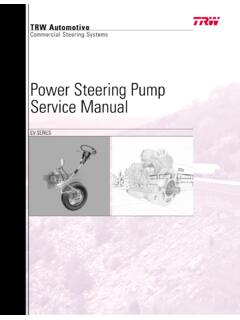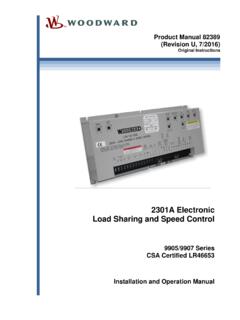Transcription of Steering System Maintenance Guidelines - TRW Aftermarket
1 TRW AutomotiveCommercial Steering SystemsSteering System Maintenance GuidelinesHazard Warning Definitions A warning describes hazards or unsafe practices which could result in severe personal injury or this troubleshooting guide, test procedures are recommended to help locate the cause of each complaint. While performing these tests, TRW advises that you TAKE NECESSARY PRECAUTIONS when working with internal vehicle components and hot hydraulic fluids. A caution describes hazards or unsafe practices which could result in personal injury or product or property note gives key information to make following a procedure easier or Steering System Analyzer (PSSA) GaugeThis guide was prepared for the purpose of providing general advice concerning the diagnosis and correction of commercial vehicle Steering related problems.
2 This guide is intended for the use of properly trained, professional mechanics, NOT Do-it-Yourselfers . Also, this guide should be used in conjunction with service manuals provided by both the vehicle and component manufacturers. Diagnosis and correction of commercial vehicle Steering related problems should only be handled by properly trained, professional mechanics who have the proper equipment, tools, instructions and know-how to perform the work properly and of the tests in this manual require the use of a PSSA. This device is a combination flow meter, shut-off valve, and pressure gauge.
3 This tool will allow you to measure flow and pressure, and provide a load on the pump through the hydraulic lines of the Steering System . This tool is required to correctly analyze a Steering System . TRW recommends that you DO NOT BEGIN TROUBLESHOOTING A Steering System WITHOUT THE USE OF A PSSA. If you are not sure how to use a PSSA, you may refer to the video available through our website at: This video compliments the tests in this book which require the use of the PSSA. TRW Inc., 20081 Table of Contents Preventative Maintenance Guidelines .
4 5 Approved Fluids and Grease ..6 Input Shaft Seal Replacement ..7 Seal Removal ..8 Seal Inspection ..9 Sector Shaft Adjustment ..10 Poppets ..11 Resetting Criteria ..11 System Identification ..12 Initial Poppet Setting Procedure ..12 Poppet Resetting Single Gear System ..13 Poppet Resetting Mirror System ..15 Poppet Resetting Reverse System ..17 Main Gear Adjustment ..18 Rotary Cylinder Adjustment ..18 Air Bleeding the Steering System ..19 Visual Identification ..19 Auto Bleed Gears ..19 Maual Bleed Gears ..20 Flushing the Steering System .
5 21 Power Steering System Analyzer (PSSA) Application and Use ..23 Installing the PSSA ..23 Power Steering Pump Test ..25 Poppet Trip Pressure Test ..26 Test Result Charts ..28 PSSA Installations (Various Gear Configurations) ..29 Linkage Inspection, Maintenance , Replacement, and Adjustment ..30 Maintenance Checklist ..30 Tie Rod End Replacement ..31 Draglink - One End Adjustable ..32 Draglink - Two end Adjustable ..33 Tie Rod Tube Assembly - One End Adjustable ..34 Tie Rod Tube Assembly - TwoEnd Adjustable ..35 Drop Center Tie Rod Tube Assembly - One End Adjustable.
6 363 Lubrication Guidelines for tie rod and draglink ends. Highway (Every 20,000 miles) Pick-up/Delivery (2x/month) Heavy Duty (Every 500 hours) Severe Duty (Every 250 hours)Use hand operated grease tie rod end pinch clamp bolt to approved OEM torque specification.(4x/year)Tighten pitman arm connection to approved torque specification.(4x/year)Check cotter pin at slotted nut on all tie rod and draglink ends. Check nut torque and replace cotter pin, if missing.(At each lube cycle)Replenish lube under dirt and water seal.
7 (2x/year)Inspect U-joint and pinch bolts. Torque to approved specification.(4x/year)If equipped with grease fittings, lube intermediate column U-joints and slip joint.(At each lube cycle)Drain reservoir and replace filter.(1x/year - Highway, 2x/year - Severe Duty)Routinely check oil level. See list of approved hydraulic fluid on following hose clamps and inspect all hydraulic hoses and connections for leakage. Bleed air from the System , if required.(2x/year)Lubricate at trunnion grease fitting with hand operated gun only.(At each lube cycle)CAUTIONN ever high pressure wash or steam clean a power Steering gear while on or off the vehicle.
8 This will force contaminants into the gear, especially through the side cover vent plug hole, input shaft seal, and output shaft seal areas. These contaminants could destroy seals, bushings, and bearings. Resulting in a reduction of Steering gear Maintenance Guidelines5 Approved Hydraulic FluidsThe type of fluid used in the power Steering System is vital to extend both the life of the components and its seals. It is necessary to utilize a Steering System fluid that is specified and approved by the vehicle manufacturer and also complies with TRW Commercial Steering Systems is recommended that and fluid specification, outside of the compliant lubricant listed, be reviewed by TRW to ensure the compatibility between the component and fluid type being recommends using one of the following fluids in the power Steering System .
9 Automatic Transmission fluid TES rating of 389 for mineral based fluids TES rating of 295 for synthetic fluids NOTEThe Steering System should be kept filled with one of the above flush the Steering System when changing to another fluid . Replace the reservoir filter after flushing the System . Fill the System with one of the recommended fluids above, only. Do not mix fluid types. Any mixture or any unapproved oil could lead to seal deterioration and leaks. A leak could ultimately cause the loss of fluid , which could result in a loss of power Steering sure to bleed the air out of the System before putting the vehicle back into Grease#2 NLGI extreme pressure, lithium based, moly filled, heavy duty SHC100 for use on greasable intermediate column slip joint NOTEMore specific procedures and intervals can be found in the vehicle manufacturers service manual.
10 These procedures are TRW s general Guidelines for Steering related preventive Maintenance . Service manuals and technical bulletins are also available through our Shaft Seal ReplacementDetecting Input Shaft Seal LeakageTRW power Steering gears incorporate an Umbrella style external dirt seal between the Steering shaft U-joint and the housing of the Steering gear. The cavity under this seal is filled by TRW at assembly with a special grease to inhibit corrosion of the input shaft near the input shaft seal. Since this Umbrella does not positively interfere with the main housing, some amount of the grease under it can migrate to the external housing surfaces.












